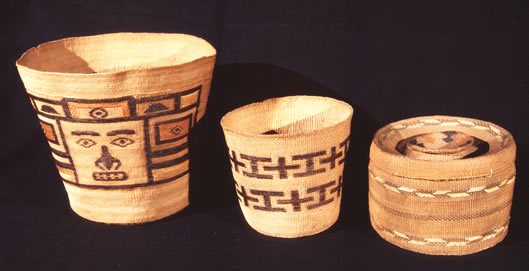
Spruce Root Baskets
“It happened when the Raven still walked among men. A woman who lived in a cloud village had a beautiful daughter of marriageable age. The Sun saw her and after his day’s travel across the sky, he took the form of a man and sought her for his wife. Many years they lived together in the Sky-Land and had many children, but the children were of the earth world like their mother. One day as the mother was watching the children play, worrying about their future, she plucked some roots and began idly to plait them together in the shape of a basket. Her husband, the Sun, knowing her fears, increased the size of the basket until it would hold her and the children, then he lowered them to Earth. They set down near Yakutat on the Alsek River and that is the reason the first baskets were made by Yakutat women.”
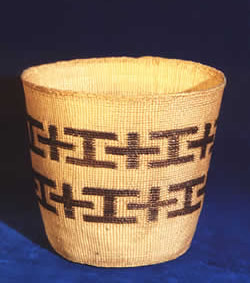
One of numerous paterns. Designs were only limited by a weaver’s imagination.
Basket making was one of the oldest and most important arts in the Tlingit economy. Woven basketry was fairly prominent in all coastal Native groups from the Aleutian Chain to the Columbia River. Many baskets, mats, bags, etc. were sewn, coiled, twined or plaited from a variety of materials. Twining (the same type of weave as used in the Chilkat Blanket) was reserved for the spruce root baskets of the Tlingit. These water-tight vessels augmented the Tlingit’s selection of wooden cooking utensils common among the Northwest Coast Indians.
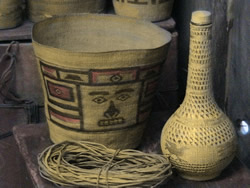
Here are several spruce root works including a narrow bottle enchased in a basket and a bundle of prepared roots.
Baskets were made to be used and their shape was dictated by the use for which they were intended. Some were cook kettles, water jars, drinking cups and food dishes. Some of the largest baskets were used for collecting and storing berries, a food staple. This twining weave turned spruce roots into work hats, headdresses for a shaman, work baskets, rattles, spoon bags, fish traps, net bags for eulachon fishing, huge mats for canoe sails, floor mats, a baby’s cradle swing or a winding sheet for an old shaman when his body was taken to the lonely burial house.
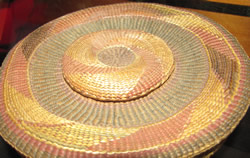
A beautifully designed lid on display at the Sheldon Museum.
Unlike the Chilkat Blanket where both men and women played an important creative role, women were the sole makers of the basket. They found, collected, and prepared the materials, then designed and wove the baskets.
The baskets, made of spruce roots, were ornamented with various types of grasses. Young roots were gathered in spring by a group of women armed with digging sticks. An experienced woman selected the proper tree and a root, which could be up to 20 feet long, was followed with sticks and hands. The bark was immediately peeled before the sap dried then the root coiled and cured over the summer.
Traditionally, weaving was done during the quiet winter months. When a woman was ready to start work, she soaked the roots until they were soft and pliable. Each root was then split lengthwise into narrow strips. The splits were started with knives (mussel shell knives were used before traders came) and finished by holding the root in position with the front teeth and splitting with the thumb and forefinger nails of the right hand. The outside of the root with its brown luster was coiled for the weft strands while the remainder was coiled separately for the warp. The center was discarded.
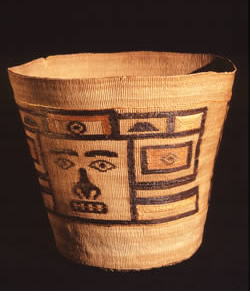
A design using false embrodiery.
The basket’s design was developed using “false embroidery”.” Dyed grass stems were wrapped around the weft so the pattern showed only on the outside of the basket. Grass was gathered in early summer when the stalks were still thin. The blades were discarded and the stems boiled until the color faded to a yellowish shade. They were dried in the sun until their color was like pale straw then dyed before being split. Traditional dyes were black, produced by soaking the grass in black mud from sulfur springs or soaked in horsetail roots; purplish black, made from dark blue huckleberries boiled and mashed in water; red, produced in a variety of ways including red ochre and steeping the stems in children’s urine in an alder bowl; yellow, produced by steeping the stems in a lichen called wolf moss; and blue-green, made by boiling hemlock bark and bits of copper ore in urine. The grass was softened for splitting by sucking water through the hollow stem then split with the thumbnail of the right hand.
Traditionally a woman sat on the floor or ground while weaving with her knees drawn up to her chin, her feet close to her body, her shoulders bent over and her arms around her knees. Today, she would use a table.
The only tools used in basket making were the knife for splitting the root and an awl – made from the spike of a goat horn, deer antler or bear claw – used to push the weft strands tightly together.
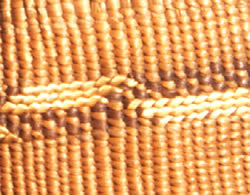
An upclose view of spruce root weaving.
There were five types of Tlingit weaving—all variations of the twined weave in which a regular series of one or more warp splints were enclosed by a crossed twining of two or more weft strands. The work progressed from left to right. “Close-together-work” (WOOSH-TUHK-AH-GEE) was the most common weave producing a watertight basket. The strawberry weave, using two different colors of weft, was a variation of the “close-together-work.”
“Between” or “middle thing” (KHAH-GEES-UT) added a single unpolished strand between each row of twined weave. HIKDJEE-HAH-ZEE meaning “rough-like-the-skin-on-a-frog’s back” twined two wefts over and under two warps. “Eye-holes” (WAHK-KUS-KAHT) was on open mesh weave. “Twisted” or “braided” (UH-TOO-KOO) was a braided twining using three weft strands, each passing over two warp splints on the outside and one on the inside.
Borders were finished by cutting the splints off even with the edge of the basket or by folding the warp splints over on the inside and binding them down with the last few lines of weft in a variety of ways. Basket making began to change by the late 1890’s. Traders who had seen the beauty of the spruce root baskets urged the women to weave baskets to sell. Women began using aniline dyes; baskets made for sale became smaller; and as metal cooking utensils became more available, some basket shapes were discontinued. A few skilled women weave baskets today. The modern lifestyle allows them to weave year-round, however, the materials and construction techniques remain the same.
Cynthia Jones, 1987
Caring For Your Basket
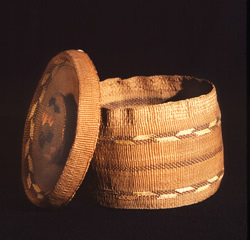
A spruce root basket with a lid.
If you’re fortunate enough to own a basket, here are some important things you should know:
- Avoid extreme temperature and humidity changes.
- Keep out of direct sunlight. The darker, the better.
- Keep dust free, either in a case or by gentle vacuuming through a mesh material.
- Examine routinely for insect infestation–little holes, fine dust.
- Handle carefully. Pick up by supporting the bottom with gloved hands.
- NEVER carry by the handle, rim or knob.
- Never wash (water or soap), varnish or shellac your basket.
- Do not stack baskets.
Bibliography:
Gunther, Erna. Design Units on Tlingit Baskets. Sheldon Jackson Museum, 1984.
Paul, Frances. Spruce Root Basketry of the Alaska Tlingit, 1944. Reprint by Sheldon Jackson College.
